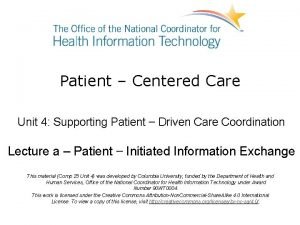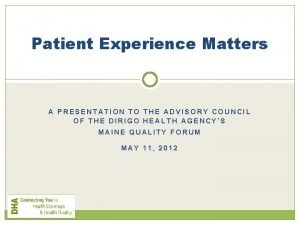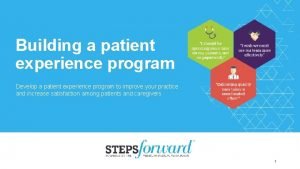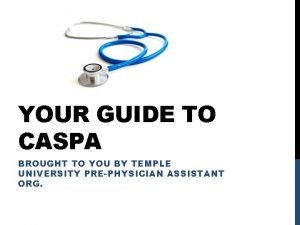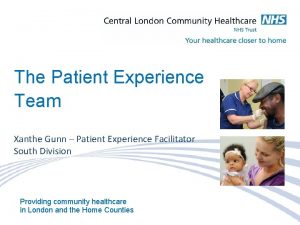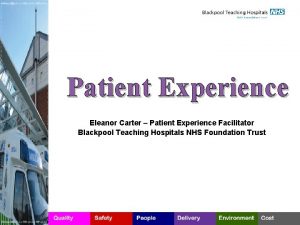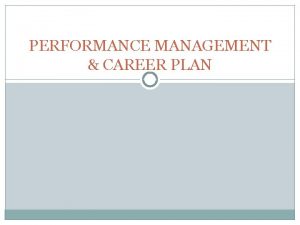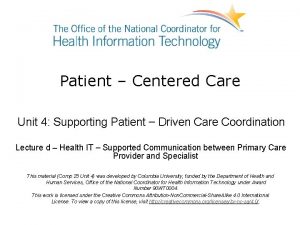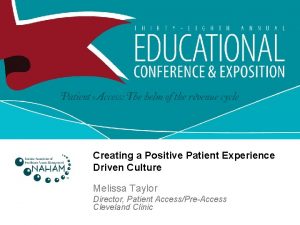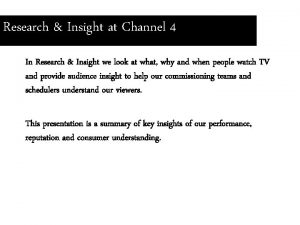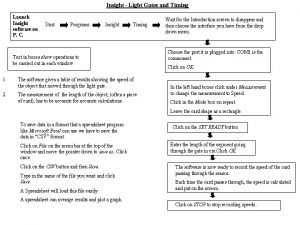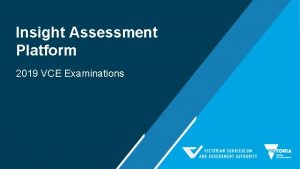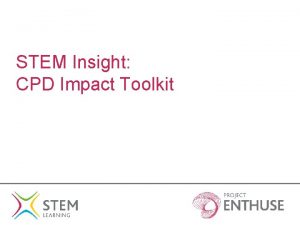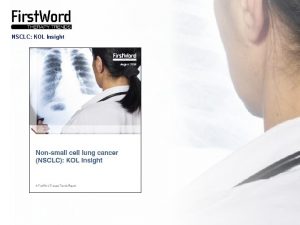PATIENT EXPERIENCE DATA DRIVEN INSIGHT TO PERFORMANCE MANAGEMENT























- Slides: 23

PATIENT EXPERIENCE: DATA DRIVEN INSIGHT TO PERFORMANCE MANAGEMENT Mark A. Walker, MHA, MBA Director of Business Development Fertility Centers of Illinois

Learning Objectives • Understanding why patient experience data and insights in the age of consumer driven medical care • Finding tools that exists to obtain patient experience data and insights • Discovering unique ways to apply these tools • Measuring data points and which are most important to your practice • Implementing data driven change in the clinical setting

“If quality is to be at the heart of everything we do, it must be understood from the perspective of patients. ” Lord Darzi, MD

Disclaimer: I don’t believe “customer service” is a strategic advantage! Weird, right? Ø Most customers have no idea what constitutes quality or how to evaluate it. Ø You put yourself in the position of having to “prove it” to the customer so they can actually see if for themselves. ü You have to be so far above the industry that it would be obvious. Anything short and the competitors can easily negate your advantage!!!

True or False: Patient satisfaction surveys are a good idea? Answer: That depends on your perspective…. Several excuses can affect perspective: ü You don’t feel the data is reliable… ü You think it’s too costly… ü Maybe you just don’t want to be measured… ü You don’t understand what you’re measuring…

A Fundamental Change in Health Care • A rapid growth in availability and use of health care information… • Growing desire to be more involved and active in decisions… • A trend towards customization of products and services leads to a marketplace of options… • Ultimately a declining level of trust in institutions like hospitals, insurance companies and even physicians… California Healthcare Foundation: http: //www. chcf. org/~/media/MEDIA%20 LIBRARY%20 Files/PDF/C/PDF%20 Consumers. In. Health. Care. Burden. Choice. pdf

Attainable Wisdom: Listen, Learn & Fulfill Organize the Opportunity Right in Front of You Difficult to measure success of care. Don’t have resources to track personal health information. Unable to make informed financial decisions. Access to timely and convenient care. Don’t feel well informed about conditions or treatment plans. Leave appointments confused about next steps. Struggle to keep provider informed. Don’t feel like anyone is coordinating their care. Real Concern Patients Do Not Feel Heard in Process!!!! Patient Needs Opportunity Patients want to be known and heard. Patients want easy access to healthcare information and services. DEMAND GENERATION Patients want to understand their disease, care plan AND want to have providers talk to each other. Patients want to be “shepherded” through the process.

Defining Research Quantitative Qualitative • Logical and data-driven. • Helps reveal a range of • Provides a measure of behavior & perceptions on a specific issue. • In-depth studies of small groups of people to guide and support the construction of hypotheses. • More descriptive rather than predictive. what people think from a statistical and numerical point of view. Ø For example, if you wanted to know how many of your patients support a proposed change in your products or service and how strongly (on a scale) they support it.

What Kind of Research? Task Research Method Monitoring Performance QUANTITATIVE Patient Experience Surveys Assessing Quality of Care Patient Experience Surveys Determining Population Priorities Local Population Surveys Patient Engagement QUALITATIVE Patient Panels Stakeholder Concerns Analyze Written Materials Attitudes and Beliefs Focus Groups Testing Services Offered Mystery Shopping Direct Observation Public Opinion Intentional Events & Conversations

Available Tools: AND MANY MORE…. A multitude of tools exist to help you capture feedback easily from your patients.

However… It’s NOT the tool that’s important! 3 Tenants of a Valuable Survey BREVITY CLARITY CONSISTENCY Even an in house survey can be valuable, if implemented correctly!

Application of Existing Tools: There are many ways to apply them in your practice Email Surveys: Paper Based Surveys:

What are the data points? t n a Qu e v i t ita • Loyalty Index – This is the Net Promoter Score (NPS). NPS is calculated on results from the “Likelihood to Recommend” question on the survey. The NPS calculation is the standard (5 s – (1 s + 2 s + 3 s)) / Total Responses). • Overall Satisfaction – This is the average of the overall experience question - “Please rate your overall experience at XYZ Practice. • Likelihood to recommend – This is the average of the likelihood to recommend – “What is the likelihood to recommend XYZ Practice to your friends and family? ”

The triangulation of Data li a Qu t e v i at

Tracking Results Over Time

Implementing Change • Change is hard: “The first step toward change is awareness. The second step is acceptance. ” Even the most change-averse physician groups are finding it difficult to stay the same.

How to Gain Buy In: • Present The Data: Graphs’ and Charts are most effective (and most well received by Physicians) • Direct and Relevant Quotes to Support Data: “I think what this comes down to is going through this process is incredibly stressful. The definition of stress is feeling like you’re not in control… There are so many things that are out of your control that every little bit that they can tell you: ‘this is what’s going on, this is what you can do, and this is what we are going to do to help you, ’ will improve that experience for us. ” • Photo’s, Video’s and Visuals: Patient Tesimonial Video

Gaining Buy In Continued… • Involve Key Stakeholders: Leadership Nurses Physicians Support Staff IT Department Patients Getting these groups involved from the start will make your task easier and will insure the final outcomes are more successful and wide-reaching.

You Have Buy In, Now What? • Create a Work Group: Be Clear with what you are trying to accomplish! Groups without clarity are doomed. Choose Participants Carefully Cross-Functional Build Relationships Match Skillset with responsibilities Delegate Specific Actions Encourage, Encourage

SMART GOALS "Many people fail in life, not for lack of ability or brains or even courage, but simply because they have never organized their energies around a goal. “ - Elbert Hubbard

SMART Goals • Specific: Determine EXACTLY what needs to be done • Measureable: Make sure you know how you will achieve • Achievable: Be realistic • Relevant: Relate the actions to important issues • Timebound: Set a specific date for completion.

Create and Action Plan A Sample Action Plan: Reduce Check in Time Identified Issue Objective Patients Check in Time is Too Long Reduce Check in Time for Patients Work Required • Check in Process Evaluation • IT System Evaluation Timescale • 1 Week = Data collection. • 2 Weeks = Systems Review • 2 Weeks = Test New Process Responsibility • Office Manager • Front Desk Staff • IT Department Link with Other Work Increase Patient Throughput and Physician Effectiveness

Questions? Mark A. Walker, MBA, MHA, EMT-P Director, Business Development Fertility Centers of Illinois mark. walker@integramed. com 1 -847 -832 -6840
 Patient driven care
Patient driven care Api driven ddi
Api driven ddi Verizon%20vehicle
Verizon%20vehicle Metadata-driven data management
Metadata-driven data management Imprint definition psychology
Imprint definition psychology Continuity vs discontinuity
Continuity vs discontinuity Indirect experience
Indirect experience Transforming patient experience
Transforming patient experience Why patient experience matters
Why patient experience matters Patient experience program
Patient experience program Caspa achievements examples
Caspa achievements examples Patient 2 patient
Patient 2 patient Bars performance appraisal
Bars performance appraisal Performance management vs performance appraisal
Performance management vs performance appraisal Hp insight agent
Hp insight agent Quotes about data driven instruction
Quotes about data driven instruction Query driven approach in data warehouse
Query driven approach in data warehouse Data driven district
Data driven district Data driven web applications
Data driven web applications Data driven robotics
Data driven robotics Data driven fraud detection
Data driven fraud detection Data driven powerpoint slides
Data driven powerpoint slides Single overarching communication outcome (soco)
Single overarching communication outcome (soco) Hypothesis driven data mining
Hypothesis driven data mining
